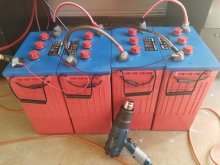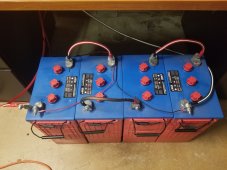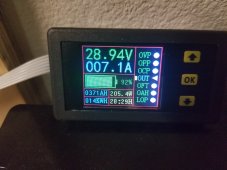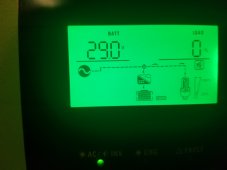You are using an out of date browser. It may not display this or other websites correctly.
You should upgrade or use an alternative browser.
You should upgrade or use an alternative browser.
Mixing Lead and LiFePO4
- Thread starter EmilyAndClark's Adventure
- Start date
TGPB
New Member
- Joined
- Aug 16, 2020
- Messages
- 134
Care to share your recovery method?Well, when a friend gives you 22 Rolls 6v 400AH lead acid batteries, it worth testing the theory. I have reconditioned 7 out of 8 so far. 7 were at 3.1v when i got them and 8th was .4v. #2 cell is dead, but i think i can fully recover it. I should create another thread on here how i mananged to do the recovery. And no, it's no using Epsom salt...lol
Care to share your recovery method?

TESTING: Lead Acid/LiFePO4 battery pack
This is my official testing thread for my lead acid/LiFePO4 battery bank testing. MPP Solar LV2424, wiring and testing equipment arrived. 8x3.2v 100AH Lifepo4 cells shipped from China. Two 24v Lead acid battery banks built, installation of all equipment and testing is scheduled for this...
I'm still profecting and validating the solution, but I'm using a DC welder to shock the batteries with high voltage to desulfate. The worst of the 8 6v 400ah battery i recieved is currently on a 4amp charger at 6.8v. When i recieved it, it was at 0.4v with the center cell completely dead. Once the battery is completely charged, i will cycle capacity test it 2 or 3 times and do a complete write up.
TESTING: Lead Acid/LiFePO4 battery pack
This is my official testing thread for my lead acid/LiFePO4 battery bank testing. MPP Solar LV2424, wiring and testing equipment arrived. 8x3.2v 100AH Lifepo4 cells shipped from China. Two 24v Lead acid battery banks built, installation of all equipment and testing is scheduled for this...diysolarforum.com
TGPB
New Member
- Joined
- Aug 16, 2020
- Messages
- 134
I have a Solar/Wind/Diesel Generator system. It is currently running on Lead Acid L16 Batteries and everything plays well together. I am putting together LiFePo4 batteries and have been looking for a way of accommodating the PMA Wind Generator.
Looking forward to the write up. I have some L16 batteries I'd like to kick some more life out of.I'm still profecting and validating the solution, but I'm using a DC welder to shock the batteries with high voltage to desulfate. The worst of the 8 6v 400ah battery i recieved is currently on a 4amp charger at 6.8v. When i recieved it, it was at 0.4v with the center cell completely dead. Once the battery is completely charged, i will cycle capacity test it 2 or 3 times and do a complete write up.
High voltage shocking usuaally just blows holes in the plates and shortens their life. Sustained elevated voltage of 2.7V/cell until SG stops rising is typically more effective for long term results, i.e., a standard equalization charge. Equalization should be terminated once battery hits 120°F.
Steps:
Fully charge in accordance with battery manufacturers absorption/float voltages
2 hours after float, check SG
Elevate voltage to 2.7V/cell hold until the sooner of SG stops rising or battery hits 120°F.
If temperature limit is hit but SG still increasing. allow battery to cool and repeat.
Other methods don't work or have poor service life. Even the above is stressful and results in reduced life.
Consult Trojan's equalization instructions. If that doesn't work, they're likely beyond hope.
Steps:
Fully charge in accordance with battery manufacturers absorption/float voltages
2 hours after float, check SG
Elevate voltage to 2.7V/cell hold until the sooner of SG stops rising or battery hits 120°F.
If temperature limit is hit but SG still increasing. allow battery to cool and repeat.
Other methods don't work or have poor service life. Even the above is stressful and results in reduced life.
I have a Solar/Wind/Diesel Generator system. It is currently running on Lead Acid L16 Batteries and everything plays well together. I am putting together LiFePo4 batteries and have been looking for a way of accommodating the PMA Wind Generator.
Looking forward to the write up. I have some L16 batteries I'd like to kick some more life out of.
Consult Trojan's equalization instructions. If that doesn't work, they're likely beyond hope.
Being i have a 24v bank of 6v 100AH batteries that started out at 3.1v per and wouldn't even TAKE a charge. That now are able to hold a 27.6v float with only .7 amps of charge and are pulling a 400 amp capacity test, not bad for batteries with holes blown in the plates. You might not want to criticize my solution, these are batteries that have sat unused for almost 5 years. You keep buying new LA batteries while i fix the ones given to me.High voltage shocking usuaally just blows holes in the plates and shortens their life. Sustained elevated voltage of 2.7V/cell until SG stops rising is typically more effective for long term results, i.e., a standard equalization charge. Equalization should be terminated once battery hits 120°F.
Steps:
Fully charge in accordance with battery manufacturers absorption/float voltages
2 hours after float, check SG
Elevate voltage to 2.7V/cell hold until the sooner of SG stops rising or battery hits 120°F.
If temperature limit is hit but SG still increasing. allow battery to cool and repeat.
Other methods don't work or have poor service life. Even the above is stressful and results in reduced life.
Consult Trojan's equalization instructions. If that doesn't work, they're likely beyond hope.
My research shows, batteries will only desulfate at higher voltages. Hard sulfation requires short burst of very high voltage to break the crystals loose. This can not be done with any normal battery charger. The batteries i shock never get much above ambient temperature. If your battery gets to 120 degrees, chances are you have a plate short and the battery is toast. A hot battery tells you something is wrong. It is being overcharged, over discharged or has a short in a cell.
Being i have a 24v bank of 6v 100AH batteries that started out at 3.1v per and wouldn't even TAKE a charge. That now are able to hold a 27.6v float with only .7 amps of charge and are pulling a 400 amp capacity test, not bad for batteries with holes blown in the plates. You might not want to criticize my solution, these are batteries that have sat unused for almost 5 years. You keep buying new LA batteries while i fix the ones given to me.
Rarely buy new batteries - typically just automotive. Have never bought a new battery for off-grid storage.
24V bank of 100Ah 6V batteries? Really? They tested to 100Ah, or they're rated for 100Ah?
In my experience, 0.7A to maintain 27.6V float is pretty bad. My ragged out T-1275s (150Ah) take 0.15A to maintain 13.6V.
My research shows, batteries will only desulfate at higher voltages. Hard sulfation requires short burst of very high voltage to break the crystals loose. This can not be done with any normal battery charger.
Right. And that's the same theory behind the desulfators. They emit high frequency pulses during charge (or float) and allegedly break it down. Problem is only the marketing material says it works. There's no data. I have tried a half dozen of them, and they've never worked.
The batteries i shock never get much above ambient temperature. If your battery gets to 120 degrees, chances are you have a plate short and the battery is toast. A hot battery tells you something is wrong. It is being overcharged, over discharged or has a short in a cell.
No. It means I'm following the manufacturer's recommendations. During over charge of a full battery at elevated voltage for equalization the energy is released as heat. This is NORMAL. It is not a sign of a problem.
I'd like to recommend that you not take things so personally. It weakens your position. Data supports your position. If you have good data, you don't need to be defensive.
I'm not claiming that anything you're doing is worthless or inherently wrong. I'm suggesting that that average person might not find it worthwhile to invest many hours of effort into rejuvenating dead 100Ah batteries into 20Ah batteries with severely reduced cycle life.
I have about 33kWh of second-life FLA (Trojan and Rolls). None of it was purchased new. The Rolls were from an off-grid grow-house the guy was unloading on CL. The T-1275 are all 3-5 year old golf cart batteries with varying degrees of abuse. All of it required substantial equalization efforts to recover lost capacity.
Speaking of data:
- What is your resting voltage after 24 hours (no charge or load)?
- What is the tested C20 capacity or tested reserve capacity of your bank?
- What is the SG range of our cells?
You would get the most from them being the first owner. Of course for FLA, you'd be investing in maintenance rituals like checking SG with a hydrometer, doing the necessary EQ when needed and so forth. It's a lot of involvement in personal time to get the most from them, and when you start new, it's do-able. But most don't start out nor maintain them properly.Rarely buy new batteries - typically just automotive. Have never bought a new battery for off-grid storage.
Right. And that's the same theory behind the desulfators. They emit high frequency pulses during charge (or float) and allegedly break it down. Problem is only the marketing material says it works. There's no data. I have tried a half dozen of them, and they've never worked.
There is data, but with a HUGE Caveat! A real catch-22. Hard sulfation physically expands and damages batteries internally, breaking grids, cracking interconnects, warping plates, and in extreme cases, totally bulging!
So the catch-22 is that even IF one got their batteries all cleaned up magically, what is left is a poor weakened zombie, totally unsuitable for its -original- use case. But you can "second life" it in another sub-c application like powering your walkway garden lights.
As you know, the high-voltage zapping is detrimental overall taking out valuable active material at the same time.
This is actually what lead to the frequency thing (typically 30khz or a wider sweep), by John Galt, rather than high-voltage zapping. Two known examples are the Pulsetech chargers, and the Battery-Minder chargers that do this with frequency, not voltage.
The idea is not to blast off the sulfate, but rather recharge it. Impossible once it hardens right? The way it is explained to consumers is that a "cleansing" takes place. Ridiculous. What they should say to us battery nerds is:
"In between the electrolyte and active material is what is known as the microscopic "interphase layer". If you can get through the interphase layer, you can recharge the material that is surrounded by a hard sulfated shell, rather than trying to use any form of zapping." Try explaining the interphase layer to the consumer. Eyes roll. Much like trying to explain the SEI layer to lithium battery users (bad analogy, but you know what I mean).
So, Pulsetech has the X-ray crystallography and data gathered from a university (Cincinatti?) Done by a university physicist, not a marketing or company droid. You don't find the FULL report easily any more. This was in the 80's or 90's last time I looked at it.
BUT - here's the thing. Most people try to revive dead-zombies where the expanding hard sulfate has already done it's damage! Hence if one wants to do it right, they use the Pulsetech or Battery-Minder in addition to proper maintenance! But usually what has preceeded their use are home grown methods first, like using arc-welder blasting, epsom salts, even aspirins, nevermind not being the first owner.
Personally, I just try to treat my batts as well as I can right from the start. And be the FIRST owner. Just wanted to add this info in case it interested anyone, since it goes all the way back to the John Galt patents who was dissatisfied with arc-welder zarping.
Disclaimer: to be absolutely honest, I will use a Pulsetech charger as a maintenance top off every once in awhile on my Optima AGM's. Not to revive them, but as part of a regular pm procedure. Kind of the whole thing to Pulsetech was to help AGM's, which are notorious for not getting fully charged by the end user. And it wasn't until it was fully explained about the need to get beyond the interphase-layer, which I understood well. But revive second-hand garbage? Not me. YMMV.
Last edited:
I haven't forgot about this tread. I'm still waiting on my 8th lifo battery to arrive from china. The original one was dropped in the packing process, so they added a new one to my followup order. Been playing with the FLA packs for a while base lining the capacity. If i take the 24v 400ah, pack down to 22v, i can pull 400+ah at a 20amp discharge rate. These are heavy duty, think plated, deep cycle batteries so they seem to be handling the discarge very well. When the inverter shutdown at 22v, the batteries bounce back to 24.1v very quickly. Any suggestions to improve my testing?
Last edited:
Looks like you recovered and tested soon after charging.
Cover some other bases like determining self-discharge to see if sure, you can recover that capacity right after charge, but can you do the same a day or two later?
What is your resting voltage on each cell after a day of rest (no load) ?
With your hydrometer, what is the SG of each cell?
This will help determine if your revived bank is practical, or just got scared into performing for only the next 10 cycles.
Cover some other bases like determining self-discharge to see if sure, you can recover that capacity right after charge, but can you do the same a day or two later?
What is your resting voltage on each cell after a day of rest (no load) ?
With your hydrometer, what is the SG of each cell?
This will help determine if your revived bank is practical, or just got scared into performing for only the next 10 cycles.
Batteries are charging now. I sat charge them at 40 amps to 29.2v then float them at 28.8v. Is this to high of a float?. Each battery has previously held a 6.4v for several days with no load or charge. I'm including a few pics. First are the rolls 6v bank, charging meter and mppt solar controller. The last is the 100 amp 24v bank that has been resting for 2+ days
Attachments
i ran 3 different type of batteries to a single busbar, one bank 4xgolf cart 6 v through victron battery disconnect,second 24v prismatic 80ah lifepo on victron battery disconnect and the third a Tesla 124ah 24v with no battery disconnect (due to 19-33 voltage range) all in a converted cargo trailer i lived in for two years with no problems. i had plenty of solar panels around 1400 watts in 4 different kinds of solar charges and spent my day and most my night running my 6k AC unit in hot weather ,it still runs good to this day with no problems,now i live in a house my tesla battery gave me a little problem but all is good now
I did a video on Youtube a bit ago about my experience with mixing Lead and LiFePO4 batteries on my sailboat (). You are all very welcome to visit that discussion but the main reason I've posted here is I'm trying to get in touch with Will.
Hi Will,
I sent an e-mail last week but it didn't seem to get through. How can we best chat? I hope you have a way to start a PM from here.
Clark
Some test data. LFP definitely discharges first but there is more of a charge share on the way up than I might have expected - but this is with an ~8:1 ratio (maybe 4:1 in reality) of lead to lithium. Additional control of the lithium charging definitely makes for an interesting convo.
LFP SOC% is brought down to essentially 0%. I.e. completely discharged on the regular.

Testing: Lead and lithium (LFP) battery banks in parallel
Will it work? What happens? How do the currents share? What do you want to know? **Note this is a controlled and supervised experiment for informational purposes only and not an endorsement to do such things** Update: Test complete. Details below in the thread.
Last edited:
Can you share how many people you think have tried this in their boats?I did a video on Youtube a bit ago about my experience with mixing Lead and LiFePO4 batteries on my sailboat (). You are all very welcome to visit that discussion but the main reason I've posted here is I'm trying to get in touch with Will.
Hi Will,
I sent an e-mail last week but it didn't seem to get through. How can we best chat? I hope you have a way to start a PM from here.
Clark
I've got it going at my off grid cabin and it works very well. When the lithium fills up, it disconnects the batteries, and my chargers (solar and wind) continue to top off my lead. When done the voltages go down and it reconnects them. I have found a lot of advantages.
Sverige
A Brit in Sweden
What voltages do you disconnect and reconnect the LFP batteries at?I've got it going at my off grid cabin and it works very well. When the lithium fills up, it disconnects the batteries, and my chargers (solar and wind) continue to top off my lead. When done the voltages go down and it reconnects them. I have found a lot of advantages.
Similar threads
- Replies
- 15
- Views
- 376
- Replies
- 6
- Views
- 470
- Replies
- 17
- Views
- 1K









